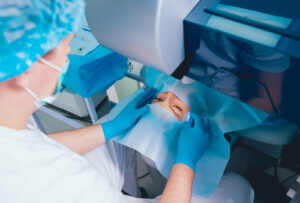If you have considered LASIK surgery, one of the first thoughts that may have come to mind is wondering how the procedure corrects vision. LASIK stands for laser-assisted in situ keratomileusis.
The LASIK procedure is a permanent refractive procedure and is the most popular method of laser vision correction. It can correct nearsightedness, farsightedness, and astigmatism.
Several hundred people consider LASIK every year as an alternative to glasses or contacts. In order to achieve its dramatic, long-lasting results, LASIK utilizes special types of lasers that gently reshape your cornea, the transparent dome at the front of your eye.
When considering any procedure, it’s essential to understand what it involves. Keep reading to find out how LASIK works!
How Is LASIK Performed?
LASIK used to require a bladed surgical instrument to perform, but not anymore! Today, LASIK is 100% bladeless for the best possible results.

State-of-the-art laser technology has replaced bladed instruments to make LASIK more effective than ever. During the LASIK procedure, Dr. Cheema will use two different types of ultra-precise lasers.
The first is an excimer laser, and the second is a femtosecond laser. Compared to bladed LASIK, the femtosecond laser creates a smoother flap with fewer irregularities.
Whether you are nearsighted, farsighted, or have astigmatism, these refractive errors require you to wear visual aids to see the world clearly. During LASIK surgery, Dr. Cheema will alter the shape of your cornea to correct your natural refractive error.
After LASIK, you will be able to experience greater visual freedom.
What Happens During LASIK Surgery?
After numbing your eye, Dr. Cheema will use a femtosecond laser to create a small flap in the top layer of your cornea. Next, Dr. Cheema will lift the flap to access the middle layers of the cornea.

Then, he will use the excimer laser to reshape this area of your cornea.
Now that the cornea has been reshaped, Dr. Cheema will replace the flap and position it for optimal healing.
One of the best features of modern laser eye surgery is that no stitches or sutures are needed. In fact, the flap will heal naturally on its own during your recovery period.
LASIK is an outpatient procedure, meaning you can return home once it’s complete. The healing process begins immediately, and the recovery period is often short.
You will likely be able to start noticing improvement in your vision within hours!
What Kind of Results Can You Expect with LASIK?
When you have LASIK, you can look forward to a world of difference. There are a couple of reasons why LASIK has the highest patient satisfaction rate of any elective procedure.

In fact, over 96 percent of people who have had LASIK are happy with their results. Furthermore, the majority of people who have had LASIK are able to reduce the need for contacts or glasses significantly.
This means that you will be able to see more clearly from when you wake up in the morning until you go to bed. When you can reduce your dependence on visual aids, everyday activities become easier, from cooking in the kitchen and looking at a computer to going for a bike ride.
With a single procedure, LASIK adds convenience to your life. Visual freedom is one of the greatest gifts you can give yourself.
Because it’s a permanent procedure, LASIK provides long-lasting results. Your cornea will remain reshaped for the rest of your life.
Although you won’t have to worry about the effects of LASIK wearing off over time, LASIK will not prevent vision changes from other eye conditions.
Who Is a Good Candidate for LASIK?
If you are eighteen years or older and desire to reduce your dependence on glasses, LASIK may be for you. However, as with any procedure, LASIK is not an ideal fit for everyone.

One of the crucial components of LASIK candidacy is corneal thickness. In order to have LASIK, your corneas need to be thick enough for Dr. Cheema to create the flap.
If your corneas are too thin, having LASIK can lead to serious complications or problems with your vision. In order to qualify for LASIK, you should be in good health, both in terms of your eyes and generally speaking, and have a stable prescription for at least one year.
Your glasses prescription must also be within certain limits that LASIK is capable of correcting. Your eye doctor will likely not qualify you for LAISK surgery if you are currently pregnant or breastfeeding.
If you don’t qualify for LASIK, there are other permanent vision correction options available. We at Cheema MD Eye Care offer EVO Visian ICL, SMILE, and PRK as alternatives to LASIK that provide similar results.
Can you envision yourself with improved sight thanks to LASIK? Schedule a LASIK consultation at Cheema MD Eye Care in Kingston, NY, today!



